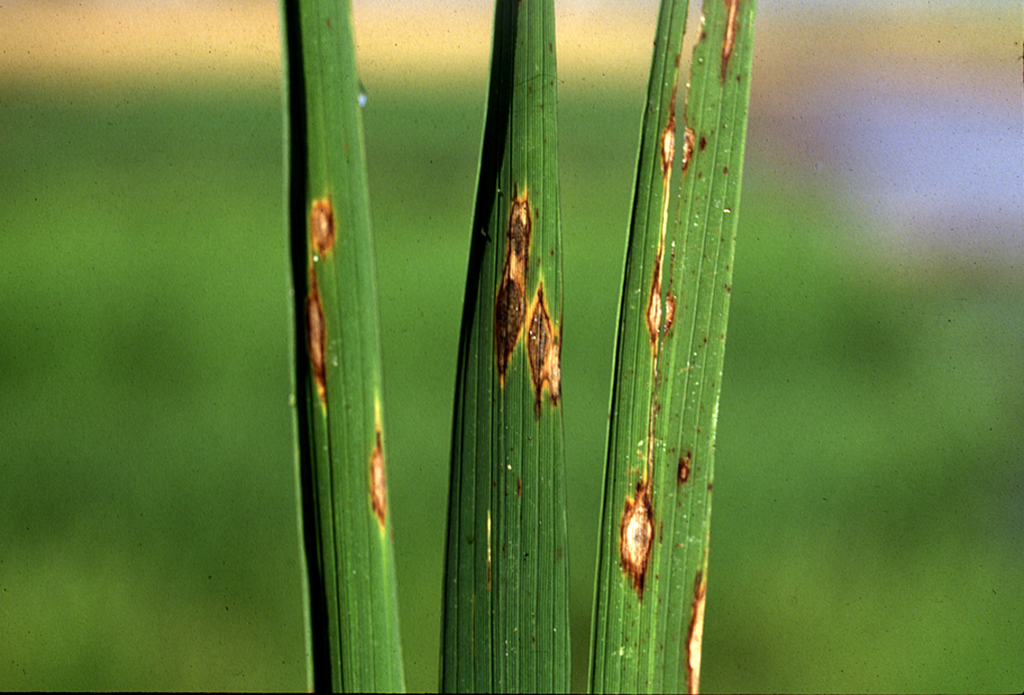
1. കുലവാട്ടം( Blast)
വായുവിലൂടെയും വിത്തിലൂടെയുമാണ് രോഗസംക്രമണം. ഇലകളില് കാണുന്ന നീലകലര്ന്ന തവിട്ട് നിറത്തിലുള്ള പുള്ളിക്കുത്തുകളാണ് ഈ രോഗത്തിന്റെ ആദ്യ ലക്ഷണം. ക്രമേണ ഇവ വലുതായി ഏതാണ്ട് കണ്ണിന്റെ ആകൃതിയില് നടുവില് ചാര നിറവും ചുറ്റും തവിട്ടുനിറവുമായി തീരും. അനുകൂല പരിതസ്ഥിതിയില് ഈ പുള്ളിക്കുത്തുകള് കൂടിചേര്ന്ന് ഇല മുഴുവന് കരിയും. കതിര് നിരക്കുന്ന സമയത്താണ് രോഗബാധ ഉണ്ടാകുന്നതെങ്കില് കതിരിന്റെ കഴുത്ത് ഭാഗത്ത് തവിട്ടുകലര്ന്ന കറുപ്പ് നിറമുണ്ടാവുകയും കതിര് ഒടിഞ്ഞുപോവുകയും ചെയ്യും. ഇതുകൊണ്ടാണ് ഈ രോഗത്തെ കുലവാട്ടം എന്നു പറയുന്നത്. കുലവാട്ടം ബാധിച്ച കതിരിലെ നെന്മണികള് മിക്കവാറും പതിരായിരിക്കും. അന്തര്വ്യാപന ശേഷിയില്ലാത്ത കുമിള്നാശിനിയായ തയോഫനേറ്റ് -Thiophanate (50WP) ഒരു ഹെക്ടറിന് 500 ഗ്രാം എന്ന നിലയില് ഉപയോഗിക്കാം. അന്തര്വ്യാപന ശേഷിയുള്ള ഇപ്രൊബെന്ഫോസ്- Iprobenfos (48EC) 500 മി.ലി അല്ലെങ്കില് കാര്പ്രോപാമിഡ് -Capropamid (27.8 SC) 500 മി.ലി. അല്ലെങ്കില് ഐസോപ്രോതയോലേന്- Isoprothiolane (40 EC) 750മി.ലി അല്ലെങ്കില് ടെബുകൊനാസോള്- Tebuconazole (250 EC) 750 മി.ലി. അല്ലെങ്കില് ട്രൈഫ്ളോക്സി സ്ട്രോബിന്- Trifloxistrobin(25%) +ടെബുകൊനാസോള്-Tebuconazole(50%) മിശ്രിതം 200 ഗ്രാം ഹെക്ടറിന് എന്ന നിലയിലും ഉപയോഗിക്കാം. അന്തര്വ്യാപന ശേഷിയുള്ള ആന്റിബയോട്ടിക്കായ ഓറിയോഫന്ഗിന്സോള്-Aureofungin sol ഹെക്ടറിന് 60 ഗ്രാമും ഉപയോഗിക്കാം. രോഗാരംഭത്തിന് മുന്പുതന്നെ പൊടിരൂപത്തിലുളള മിത്രകുമിളായ സ്യൂഡൊമോണാസ് ഫ്ളൂറസെന്സ് -Psuedomonas flourescens വിത്തു പരിചരണം (10 ഗ്രാം/ കി.ഗ്രാം)വിത്ത് + മണ്ണില് ചേര്ക്കല് (2.5കി.ഗ്രാം/ ഹെക്ടര്) പറിച്ചുനട്ട് ഒരാഴ്ചയ്ക്കുശേഷം + നെല്ലോലയില് തളിച്ചു കൊടുക്കല് (10 ഗ്രാം/ ലിറ്റര്) ഒരു മാസത്തിന് ശേഷം ഇത് ഫലപ്രദമാണ്.
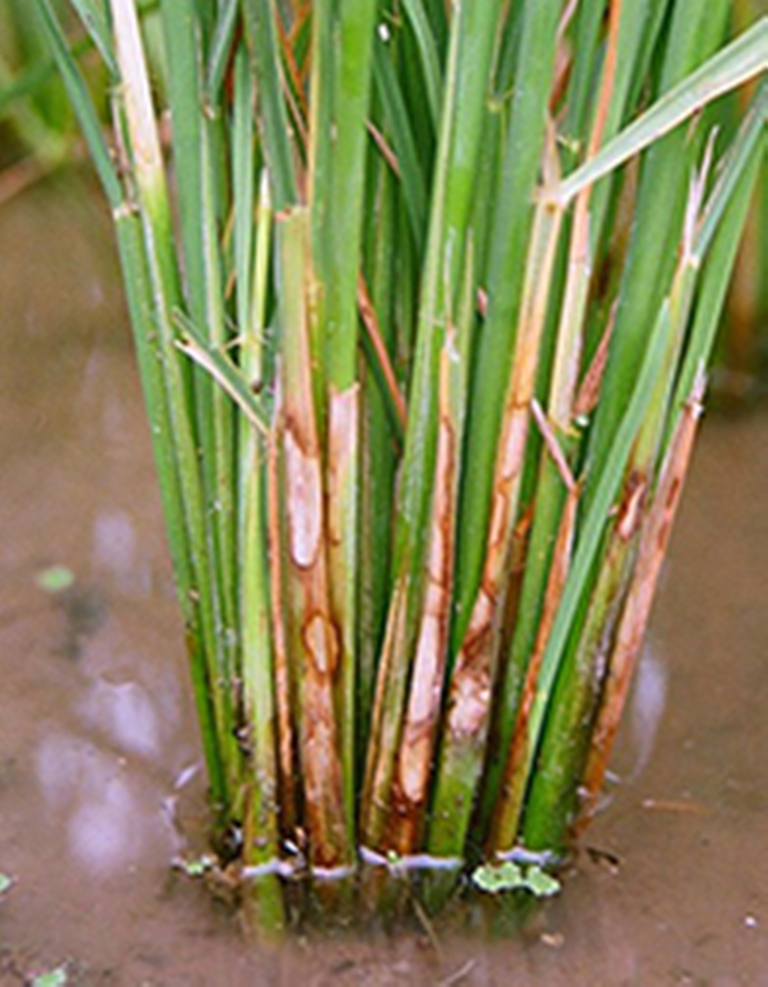
(Blast is caused by the fungus Magnaporthe oryzae. It can affect the leaf, collar, node, neck, parts of panicle, and sometimes leaf sheath.Blast can occur wherever blast spores are present.
It occurs in areas with low soil moisture, frequent and prolonged periods of rain shower, and cool temperature in the daytime. In upland rice, large day-night temperature differences that cause dew formation on leaves and overall cooler temperatures favor the development of the disease.Rice can have blast in all growth stages. However, leaf blast incidence tends to lessen as plants mature and develop adult plant resistance to the disease.Initial symptoms appear as white to gray-green lesions or spots, with dark green borders.Older lesions on the leaves are elliptical or spindle-shaped and whitish to gray centers with red to brownish or necrotic border.Rice blast is one of the most destructive diseases of rice. A leaf blast infection can kill seedlings or plants up to the tillering stage. At later growth stages, a severe leaf blast infection reduces leaf area for grain fill, reducing grain yield.Leaf blast can kill rice plants at seedling stage and cause yield losses in cases of severe infection.The primary control option for blast is to plant resistant varieties.Other crop management measures are adjust planting time,sow seeds early, when possible, after the onset of the rainy season,split nitrogen fertilizer application in two or more treatments,excessive use of fertilizer can increase blast intensity,flood the field as often as possible.Silicon fertilizers (e.g., calcium silicate) can be applied to soils that are silicon deficient to reduce blast. However, because of its high cost, silicon should be applied efficiently. Care should be taken to ensure that the straw is free from blast as the fungus can survive on rice straw and the use of infected straw as a silicon source can spread the disease further.Systemic fungicides like triazoles and strobilurins can be used judiciously for control to control blast. A fungicide application at heading can be effective in controlling the disease.
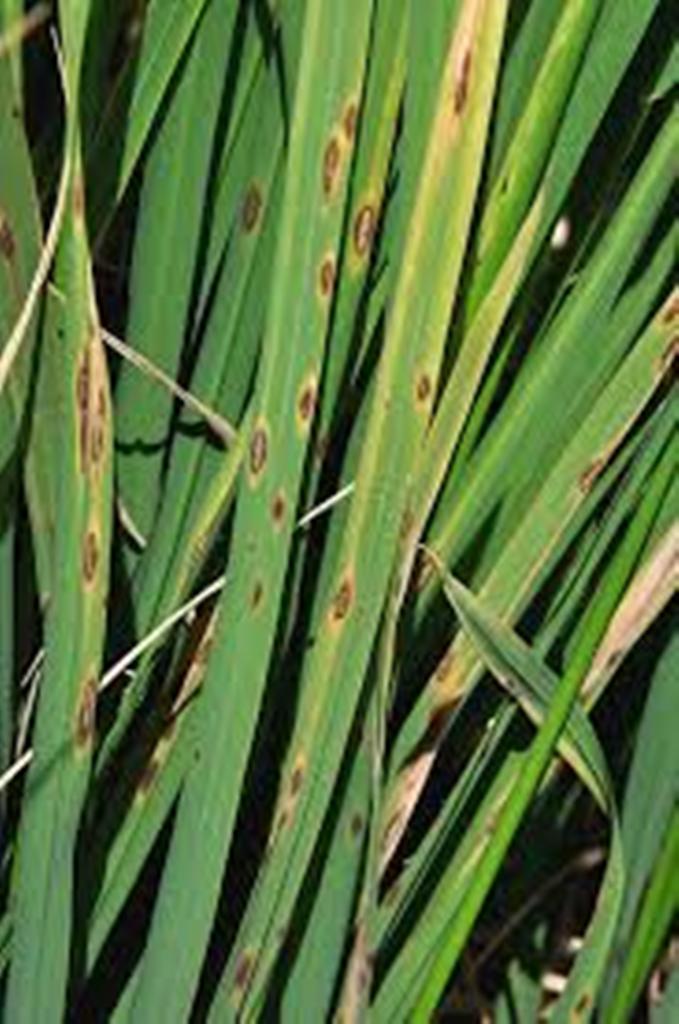
2. പോളരോഗം(Sheath blight)
രോഗഹേതുവായ കുമിളിന് മണ്ണില് വര്ഷങ്ങളോളം ജീവിക്കാന് കഴിയും. നെല്ചെടിയുടെ ഏറ്റവും പുറമെയുള്ള ഓലകള് മഞ്ഞനിറമാകുന്നതാണ് പെട്ടെന്നുകാണുന്ന ലക്ഷണം.കടഭാഗം നോക്കിയാല് ജലനിരപ്പിന് തൊട്ട് മുകളിലായി ഇലപ്പോളകളില് കറുത്ത പാടുകള് കാണാം.ചിലപ്പോള് തിളച്ച വെള്ളം വീണുപൊള്ളിയതുപോലെ ചാരനിറം കലര്ന്ന ഇളം പച്ച പാടുകളായിരിക്കും. ഈ പാടുകള് ക്രമേണ തണ്ടുമുഴുവന് വ്യാപിച്ച് ഇലകളിലേക്കും പടരാം. അങ്ങിനെ വന്നാല് പോളകളും ഇലകളും അഴുകി വിള മൊത്തമായും നശിക്കാന് ഇടയുണ്ട്. കതിര് വരുന്ന പ്രായത്തിലാണ് രോഗബാധയെങ്കില് കതിര് വരാതിരിക്കുകയോ അഥവാ വന്നാല് തന്നെ മണികള് പതിരാവുകയോ ചെയ്യും. അന്തര്വ്യാപന ശേഷിയില്ലാത്ത കുമിള്നാശിനിയായ തയോഫനേറ്റ് -Thiophanate (50WP) ഒരു ഹെക്ടറിന് 500 ഗ്രാം എന്ന നിലയില് ഉപയോഗിക്കാം. അന്തര്വ്യാപന ശേഷിയുള്ള ഇപ്രൊബെന്ഫോസ്- Iprobenfos (48EC) 500 മി.ലി അല്ലെങ്കില് കാര്ബെന്ഡാസിം(50WP) 500 ഗ്രാം അല്ലെങ്കില് കാര്ബോക്സിന്(75/80WP) 500ഗ്രാം അല്ലെങ്കില് ഹെക്സാകോണാസോള്(5 EC) 800-1000 മി.ലി. അല്ലെങ്കില് പ്രോപ്പികോണാസോള്(25EC) 500 മി.ലി ഹെക്ടറിന് എന്ന നിലയിലും ഉപയോഗിക്കാം. അന്തര്വ്യാപന ശേഷിയുള്ള ആന്റിബയോട്ടിക്കായ വാലിഡാമൈസിന് 3%ലായനി 1000 മി.ലി 500 ലിറ്റര് വെള്ളത്തിലും ഉപയോഗിക്കാം.മിത്രകുമിളുകളായ സ്യൂഡൊമോണാസ് ഫ്ളൂറസെന്സും -Psuedomonas flourescens ട്രൈക്കോഡെര്മ്മ വിറിഡെയും പോളരോഗത്തിന് എതിരെ വളരെ ഫലപ്രദമാണ്.രോഗാരംഭത്തിന് മുന്നെ തന്നെ പൊടിരൂപത്തിലുളള ട്രൈക്കോഡെര്മ്മ വിറിഡെ വിത്തു പരിചരണം (10 ഗ്രാം/ കി.ഗ്രാം)വിത്ത് + മണ്ണില് ചേര്ക്കല് (2.5കി.ഗ്രാം/ ഹെക്ടര്) പറിച്ചുനട്ട് ഒരാഴ്ചയ്ക്കുശേഷം + നെല്ലോലയില് തളിച്ചു കൊടുക്കല് (10 ഗ്രാം/ ലിറ്റര്) ഒരു മാസത്തിന് ശേഷം പ്രയോഗിക്കുന്നത് പോളരോഗത്തിന് ഫലപ്രദമാണ്.ജൈവകീടനാശിനിയും ഫലപ്രദമാണ്. വേപ്പധിഷ്ഠിത കീടനാശിനി തളിക്കുകയാണ് വേണ്ടത്. അസാഡിറാക്ടിന് 0.15% WSP 2.5 ലി/ ഹെക്ടര് അഥവാ അസാഡിറാക്ടിന് EC 0.03% 2.5 ലി/ ഹെക്ടര് പോളരോഗത്തിന്റെ ആരംഭത്തില് തളിച്ചുകൊടുക്കേണ്ടതാണ് (KAU suggests)
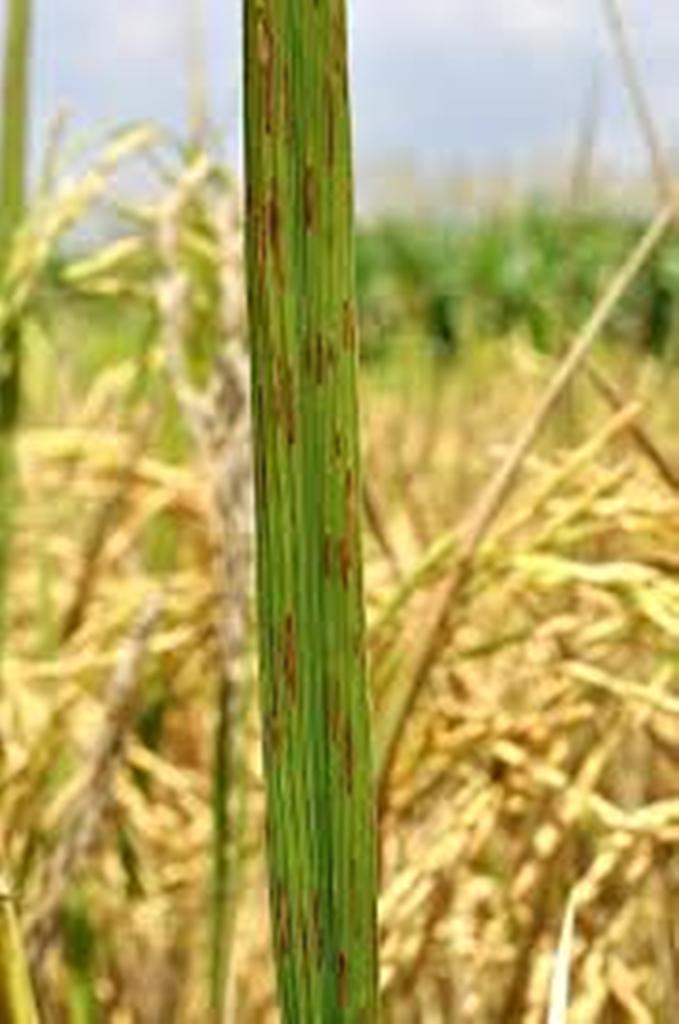
Sheath blight is a fungal disease caused by Rhizoctonia solani. Infected leaves senesce or dry out and die more rapidly, young tillers can also be destroyed.As a result, the leaf area of the canopy can significantly be reduced by the disease. This reduction in leaf area, along with the diseased-induced senescence of leaves and young infected tillers are the primary causes of yield reduction.
Sheath blight occurs in areas with high temperature (2832°C), high levels of nitrogen fertilizer, and relative humidity of crop canopy from 85100%. Plants are more vulnerable to sheath blight during the rainy season.High seeding rate or close plant spacing, dense canopy, disease in the soil, sclerotia or infection bodies floating on the water, and growing of high yielding improved varieties also favor disease development.Symptoms are usually observed from tillering to milk stage in a rice crop and include the following: oval or ellipsoidal greenish gray lesions, usually 1-3 cm long, on the leaf sheath, initially just above the soil or water level in the case of conventionally flooded rice, under favorable conditions, these initial lesions multiply and expand to the upper part of the sheaths, the leaves, and then spread to neighboring tillers belonging to different hills (transplanted rice) or plants (direct-seeded rice), lesions on the leaves usually have irregular lesions, often with gray-white centers and brown margins as they grow older.There is currently no resistant rice variety available for cultivation. The main management options available to minimize sheath blight include: use a reasonable level of fertilizer adapted to the cropping season, use reasoned density of crop establishment (direct seeding or transplanting), carefully control of weeds, especially on the levees, drain rice fields relatively early in the cropping season to reduce sheath blight epidemics, use fungicide to treat seeds, improve canopy architecture by reducing seeding rate or providing wider plant spacing.
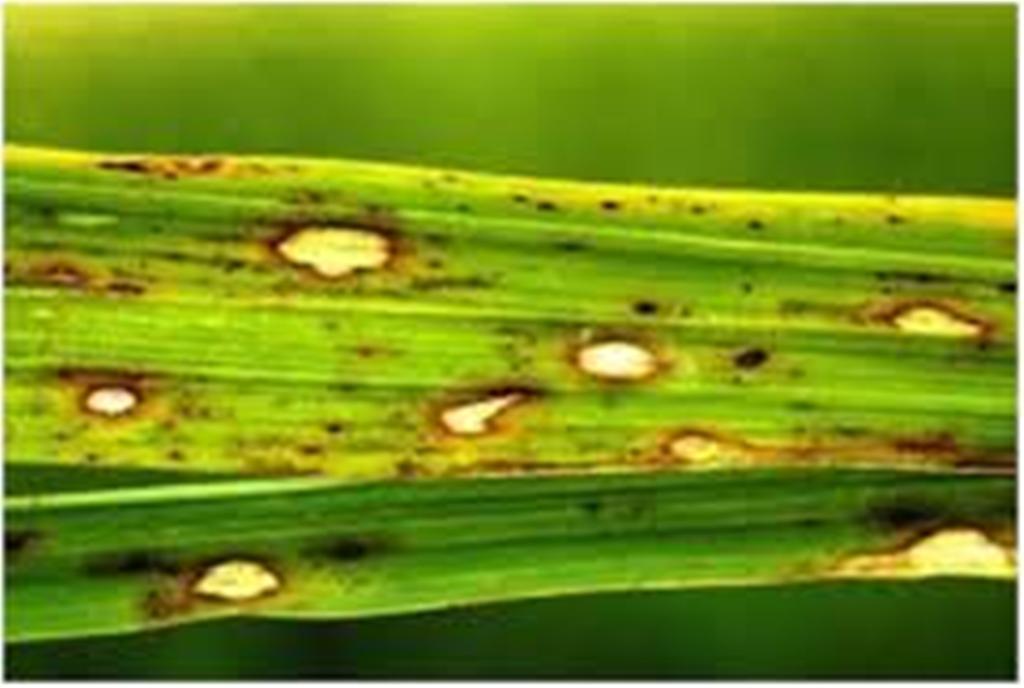
തവിട്ടു പുള്ളിക്കുത്ത് ( Brown spot)
ഒന്നാം വിളയുടെ അവസാന ഘട്ടത്തിലാണ് രോഗം സാധാരണ കാണുന്നത്. എന്നാല് രണ്ടാം വിളയില് ഞാറ്റടിയില് തന്നെ രോഗബാധയുണ്ടാകാം. ഞാറ്റടിയില് ഈ രോഗം വന്നാല് ഞാറ് കരിഞ്ഞു നശിച്ചു പോകാന് ഇടയുണ്ട്. നെല്ലോലകളില് അണ്ഡാകൃതിയിലോ വൃത്താകൃതിയിലോ കാണുന്ന തവിട്ടുനിറത്തിലുളള ചെറിയ പുള്ളിക്കുത്തുകളാണ് രോഗലക്ഷണം. പുള്ളികള്ക്കു ചുറ്റും മഞ്ഞനിറവും കാണാം. നെന്മണികളെയും രോഗം ബാധിക്കാം. നെന്മണികളില് കറുത്തപുള്ളികള് കാണാവുന്നതാണ്. വിത്തിലൂടെയും വായുവിലൂടെയുമാണ് രോഗസംക്രമണം. അന്തര്വ്യാപന ശേഷിയില്ലാത്ത കുമിള്നാശിനിയായ മാങ്കോസെബ് (75WP) -Mancozeb ഹെക്ടറിന് 2 കി.ഗ്രാം എന്ന നിലയിലോ പ്രൊപ്പിനെബ്(50WP) -Propineb 1.25 കി.ഗ്രാമോ ഉപയോഗിക്കാം. അന്തര്വ്യാപനശേഷിയുള്ള ഹെക്സാകോണോസോള്(5EC) -Hexaconazol - 800-1000 മി.ലി. ഹെക്ടറൊന്നിന് എന്ന നിലയിലോ ട്രൈഫ്ളോക്സി സ്ട്രോബിന് -Trifloxi strobin (25%)+ടെബുകൊനാസോള്- Tebuconazol (50%) മിശ്രിതം 200 ഗ്രാമോ ഉപയോഗിക്കാം. അന്തര്വ്യാപന ശേഷിയുള്ള ആന്റിബയോട്ടിക് ഓറിയോഫന്ഗിന്സോള് 60 ഗ്രാം ഹെക്ടറൊന്നിന് എന്ന നിലയിലും ഉപയോഗിക്കാം.
Brown spot is a fungal disease that infects the coleoptile, leaves, leaf sheath, panicle branches, glumes, and spikelets. Its most observable damage is the numerous big spots on the leaves which can kill the whole leaf. When infection occurs in the seed, unfilled grains or spotted or discolored seeds are formed. The disease can develop in areas with high relative humidity (86100%) and temperature between 16 and 36°C. It is common in unflooded and nutrient-deficient soil, or in soils that accumulate toxic substances.The fungus can survive in the seed for more than four years and can spread from plant to plant through air. Major sources of brown spot in the field include infected seed, which give rise to infected seedlings, volunteer rice, infected rice debris and weeds.Brown spot can occur at all crop stages, but the infection is most critical during maximum tillering up to the ripening stages of the crop. Infected seedlings have small, circular, yellow brown or brown lesions that may girdle the coleoptile and distort primary and secondary leaves. In terms of history, Brown spot was considered to be the major factor contributing to the Great Bengal Famine in 1943.Improving soil fertility is the first step in managing brown spot. It can be achieved through monitoring soil nutrients regularly, by applying required fertilizers, for soils that are low in silicon, apply calcium silicate slag before planting.Fertilizers, however, can be costly and may take many cropping seasons before becoming effective. More economical management options include use of resistant varieties,use fungicides (e.g., iprodione, propiconazole, azoxystrobin, trifloxystrobin, and carbendazim) as seed treatments,treat seeds with hot water (5354°C) for 1012 minutes before planting, to control primary infection at the seedling stage and to increase effectiveness of treatment, pre-soak seeds in cold water for eight hours.
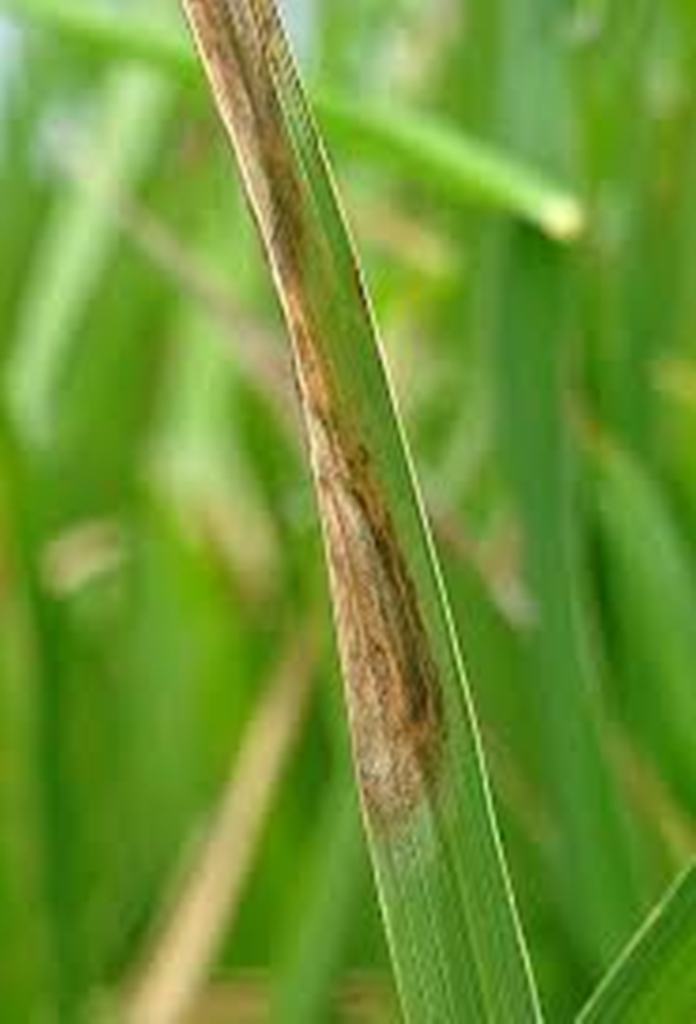
വീതികുറഞ്ഞ തവിട്ട് പുള്ളിക്കുത്ത് (Narrow brown spot)
നെല്ചെടിയുടെ ഏത് വളര്ച്ചാ ഘട്ടത്തിലും ഈ രോഗം ബാധിക്കാമെങ്കിലും സാധാരണയായി അവസാനഘട്ടത്തിലാണ് കൂടുതല് കാണുന്നത്. തവിട്ടുനിറത്തില് വീതി കുറഞ്ഞ് 2 മുതല് 10 മി.മീ.വരെ നീളമുള്ള വരകളുണ്ടാകുന്നതാണ് ലക്ഷണം. വിത്തിലൂടെയും വായുവിലൂടെയും രോഗം സംക്രമിക്കാം.
Narrow brown spot is caused by the fungus Sphaerulina oryzina and can infect leaves, sheaths, and panicles.It leads to premature death of leaves and leaf sheaths, premature ripening of grains, and in severe cases, lodging of plants.The disease usually occurs in potassium deficient soils, and in areas with temperature ranging from 2528°C.It appears during the late growth stages of the rice crop, starting at heading stage.Plants are most susceptible during panicle initiation onwards, and damage becomes more severe as plants approach maturity. To avoid the disease,use resistant varieties,keep fields clean,remove weeds and weedy rice in the field and nearby areas to remove alternate hosts that allow the fungus to survive and infect new rice crops,use balanced nutrients; make sure that adequate potassium is used,if narrow brown spot poses a risk to the field, spray propiconazole at booting to heading stages.
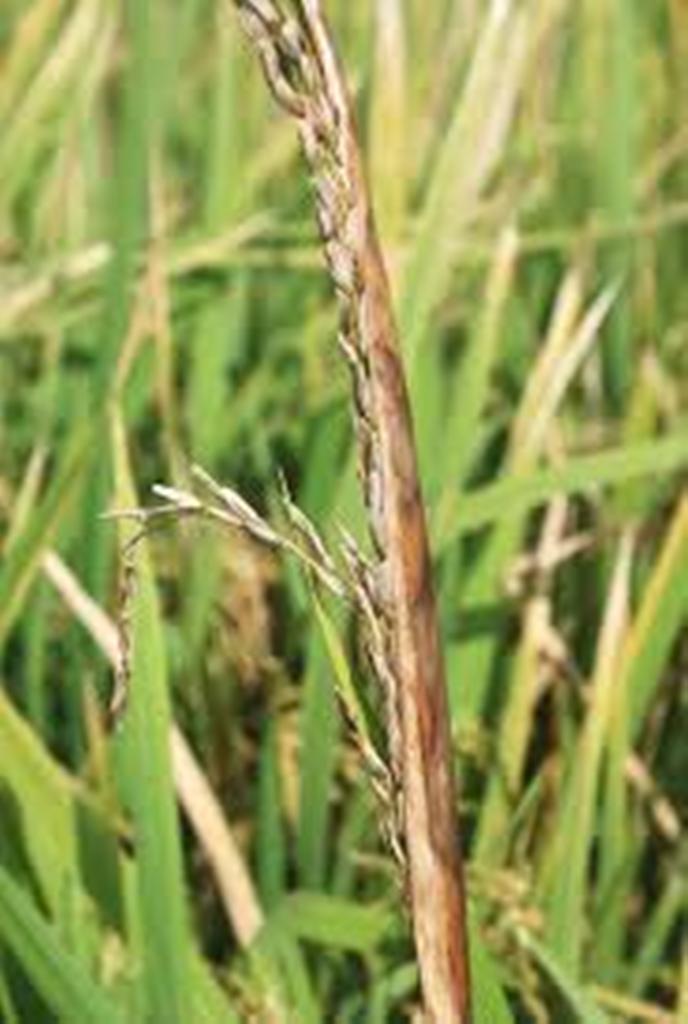
സ്റ്റാക്ക് ബേണ് (Stack burn)
വളരെ ചെറിയ തോതില് മാത്രം കാണുന്ന രോഗമാണിത്. ഇലകളില് തവിട്ടുനിറത്തില് വൃത്താകൃതിയിലോ ദീര്ഘവൃത്താകൃതിയിലോ ഉള്ള പാടുകള് ഉണ്ടാകുന്നതാണ് ആദ്യ ലക്ഷണം. പിന്നീട് ഈ പൊട്ടുകളുടെ മധ്യഭാഗം ഇളം തവിട്ടുനിറത്തിലോ വെള്ളനിറത്തിലോ ആകും. നെന്മണികളിലും കടും തവിട്ടുനിറത്തിലോ ഇളം പിങ്ക് നിറത്തിലോ ഉള്ള പൊട്ടുകള് കാണും.
Leaves and ripening grains are affected. On leaves circular to oval spots with dark brown margins are formed. The center of the spot turns light brown or white with numerous minute dots. On the glumes reddish brown spots appear. The kernels may shrivel and become brittle.To avoid it, treat the seeds with Thiram or Captan or Mancozeb at 2g/kg,hot water treatment at 54 degree C for 15 minutes is also effective,burn the stubbles and straw in the field.
ലീഫ് സ്കാള്ഡ്( leaf scald)
ഇലയുടെ അറ്റത്ത് നിന്നോ വശങ്ങളില് നിന്നോ തുടങ്ങുന്ന ദീര്ഘവൃത്താകൃതിയിലുള്ള ജലസിക്തമായ പാടുകളാണ് പ്രാരംഭലക്ഷണം. പിന്നീട് ഈ പാടുകളില് ഇടവിട്ട് കടും തവിട്ടുനിറത്തിലും ഇളം തവിട്ടുനിറത്തിലും തിരമാലകള്പോലെയുള്ള വരകളുണ്ടാകും.
Leaf scald is a fungal disease caused by Microdochium oryzae, which causes the scalded appearance of leaves.Disease development usually occurs late in the season on mature leaves and is favored by wet weather, high nitrogen fertilization, and close spacing.It develops faster in wounded than in unwounded leaves.The sources of infection are seeds and crop stubbles. Wet weather and high doses of nitrogenous fertilizer favor the disease. symptoms are zonate lesions of alternating light tan and dark brown starting from leaf tips or edges, oblong lesions with light brown halos in mature leaves and translucent leaf tips and margins. To avoid it,use resistant varieties, avoid high use of fertilizer,apply Nitrogen in split, use benomyl, carbendazim, quitozene, and thiophanate-methyl to treat seeds, in the field, spraying of benomyl, fentin acetate, edifenphos, and validamycin significantly reduce the incidence of leaf scald, foliar application of captafol, mancozeb, and copper oxychloride also reduces the incidence and severity of the fungal disease.
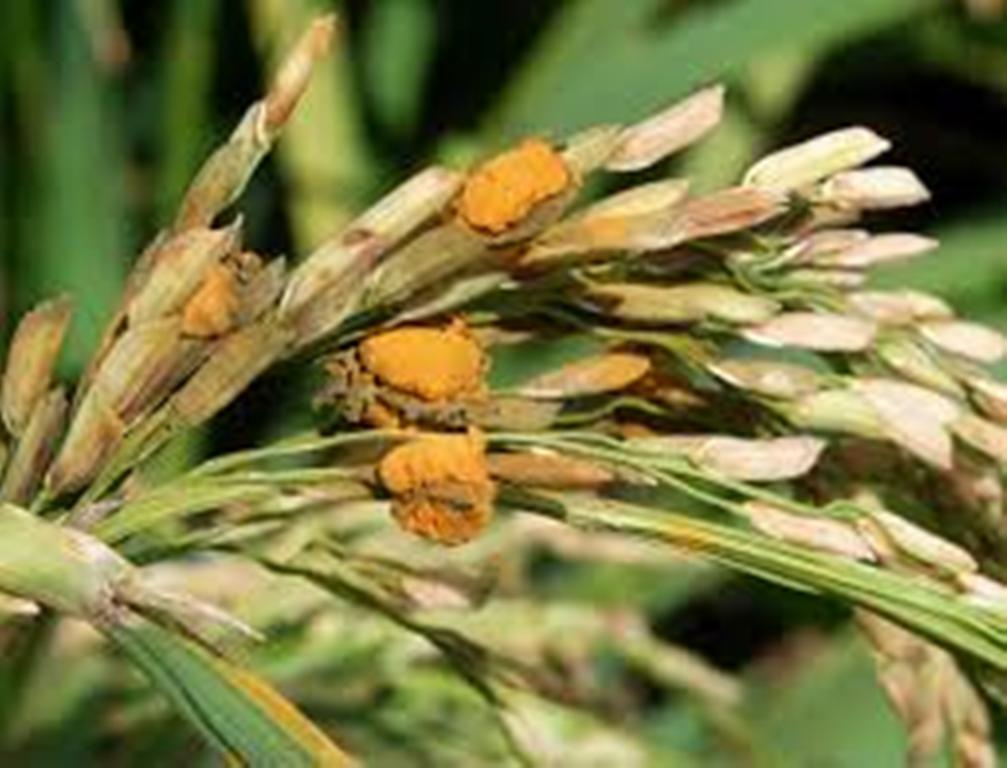
പോള അഴുകല് ( Sheath rot)
കതിര് വരുന്ന സമയത്താണ് രോഗം പ്രത്യക്ഷപ്പെടുന്നത്. ഒന്നാം വിളയില് വൈകി നടുന്ന അവസരങ്ങളില് ഈ രോഗം കൂടുതല് കാണുന്നു. കതിരിനെ പൊതിഞ്ഞുവരുന്ന പോളയില് കറുത്തതോ തവിട്ടുനിറത്തിലുള്ളതോ ആയ പാടുകള് ഉണ്ടാകുന്നതാണ് ആദ്യ ലക്ഷണം. ക്രമേണ പോള അഴുകും. അഴുകിയ പോളകള്ക്കുള്ളില് വെളുത്ത നിറത്തിലുളള പൂപ്പല് കാണാം.
Sheath rot is caused by Sarocladium oryzae.The disease reduces grain yield by retarding or aborting panicle emergence, and producing unfilled seeds and sterile panicles. Sheath rot also reduces grain quality by causing panicles to rot and grains to become discolored.Its incidence increases with increasing planting density and in plants that provide entry points for the fungus, in the form of injuries and wounds caused by insects such as stem borers at panicle initiation stage. The fungus tends to cause rotting of the uppermost leaf sheaths enclosing young panicles, which retards or aborts their emergence.It can also occur in areas with high amounts of nitrogen fertilizer application and high relative humidity and temperatures (2028°C) at heading to mature crop stages. Sheath rot is a seed-borne disease, use healthy seeds. Minimize insect infestation in rice field. Insects cause injuries to the plants that allow the fungi to enter the plant and cause infection. The fungi survive on rice crop residue after harvest and can cause infection in following seasons. Remove infected stubbles after harvest. Use optimum plant spacing. Sow three plants per hill at 20 cm row spacing. Apply potash at tillering stage. Apply foliar spray of calcium sulfate and zinc sulfate. Apply a seed treatment fungicide like carbendazim, edifenphos, or mancozeb as seed treatment and foliar spraying at booting stage. Apply a foliar fungicide like benomyl and copper oxychloride as foliar sprays.
ലക്ഷമീ രോഗം ( False smut)
കതിരിന്റെ ചില മണികളില് മാത്രമാണ് സാധാരണ രോഗബാധയുണ്ടാവുക. രോഗം ബാധിച്ച നെന്മണികള് അതിന്റെ ഇരട്ടിയോളം വലിപ്പത്തില് ഗോളാകൃതിയില് കുമിളിന്റെ സ്പോറുകളുടെ കൂട്ടമായി മാറും. ആദ്യം മഞ്ഞ നിറമുള്ള മണികള്ക്ക് ക്രമേണ പച്ചനിറമോ കറുപ്പുനിറമോ ആകും.
False smut causes chalkiness of grains which leads to reduction in grain weight. It also reduces seed germination.The disease can occur in areas with high relative humidity (>90%) and temperature ranging from 2535 ºC. Rain, high humidity, and soils with high nitrogen content also favors disease development. Wind can spread the fungal spores from plant to plant.False smut is visible only after panicle exsertion. It can infect the plant during flowering stage.Plants infected with false smut have individual rice grain transformed into a mass of spore balls. These spore balls are initially orange, and then turn into greenish black when these mature.It can be prevented by keeping the field clean,removing infected seeds, panicles, and plant debris after harvest,reducing humidity levels through alternate wetting and drying (AWD) rather than permanently flooding the fields,by performing conservation tillage and continuous rice cropping,using moderate rates of Nitrogen,using certified seeds,resistant varieties have been reported. Treat seeds at 52°C for 10 min.
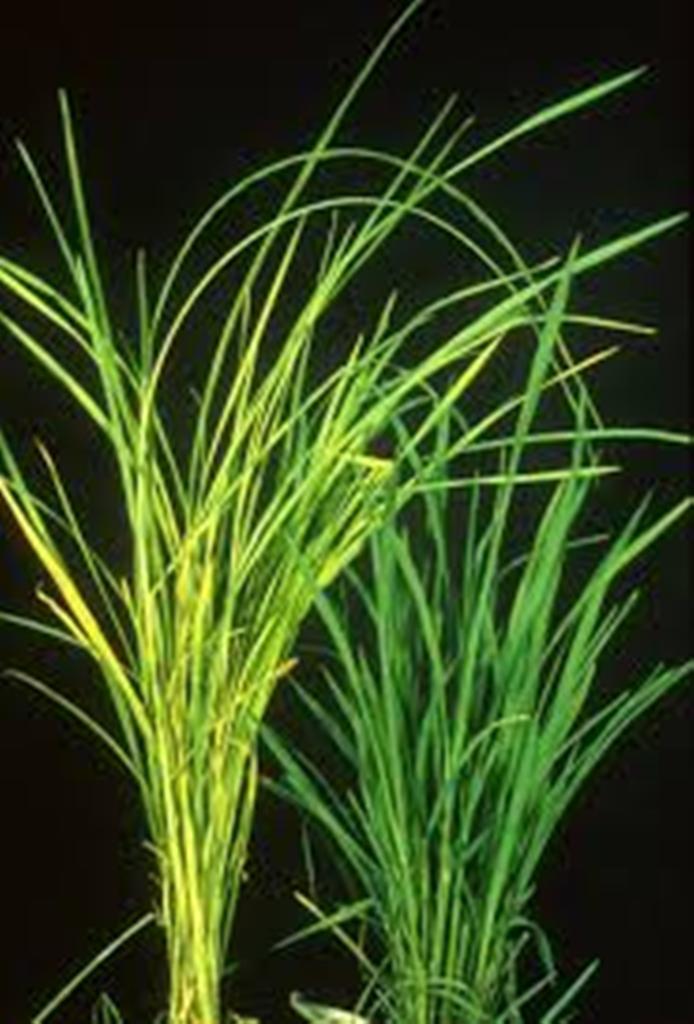
ഉഡ്ബത്ത (Udbatha)
ഇടുക്കി,വയനാട് ജില്ലകളിലെ ഉയര്ന്ന പ്രദേശങ്ങളില് മൂപ്പുകൂടിയ ഇനങ്ങളിലാണ് ഈ രോഗം സാധാരണയായി കാണുന്നത്. നല്ല കതിരിന് പകരം നെന്മണികളെല്ലാം പതിരായി പരസ്പരം ഒട്ടിപിടിച്ച് ചന്ദനത്തിരിപോലെയുള്ള കതിരാണ് വരിക. ആദ്യം ചാരനിറവും പിന്നീട് കറുപ്പുനിറവുമാകും.
A white mycelial mat ties panicle branches together so that panicle emerge as single, straight, dirty coloured, cylindrical rods much resembling an agarbatti or udbattta, hence the name. White mycelium and conidia form narrow stripes on the flag leaves along the veins before the panicles emerge. No grains are formed on the affected ear. The diseased plants produce distorted earheads later. Infection of the seeds is initiated at the time of emergence of the panicle. It is reported to occur in severe forms in many parts of South India, including Madurai district in Tamil Nadu, Wynaad in Kerala and Kollegal and South Kanara districts in Karnataka. To avoid it, use disease free seeds for sowing,seed treatment with Captan or Thiram,hot water treatment of the seeds at 50-540 C for 10 minutes before sowing gives effective control of the disease,solar treatment of seeds is effective in killing the pathogen carried in the seeds, if any.It is also advisable to avoid using seeds from fields where the disease is noted. Removal and destruction of diseased panicles in the field .
മൂട് ചീയല്( Foot rot or bakanae)
ഞാറ്റടിയിലും ആദ്യ വളര്ച്ചാ ഘട്ടങ്ങളിലും ചെടികള്ക്ക് അസാധാരണമായ രീതിയില് ഉയരം വയ്ക്കുന്നതാണ് പ്രധാനലക്ഷണം. ചെടികള് ശോഷിച്ച് മഞ്ഞളിച്ച് ഇരിക്കുന്നതായും മണ്ണിന് മുകളിലുള്ള മൂടുകളില് നിന്ന് വേരുകള് വളരുന്നതായും കാണാം. ചിനപ്പുകള് കുറയുകയും കതിര് പതിരാവുകയും ചെയ്യും. വിത്തിലൂടെയാണ് രോഗസംക്രമണം നടക്കുക.
Bakanae is a seedborne fungal disease. The fungus infects plants through the roots or crowns. It then grows systemically within the plant.Infected plants are abnormally tall with pale, thin leaves, produce fewer tillers, and produce only partially filled or empty grains.The disease occurs most frequently when infested seeds (i.e., seeds covered in fungal spores) are used, but also can occur when the pathogen is present on plant material or in the soil. It spreads through wind or water that carries the fungal spores from one plant to another.Bakanae can also be transmitted during farm operations such as harvesting infected plants allowing fungal spores to spread to the healthy seeds, and soaking seeds in water that contains the fungus.
How to manage:
Use clean seeds to minimize the occurrence of the disease, Use salt water to separate lightweight, infected seeds during soaking,Use fungicides as seed treatments. Because the disease is commonly spread through spores on the surface of the seed, applying a fungicide containing benomyl or benomyl-t (at 1-2% of seed weight) for dry seed coating to treat infested seed can be effective. Soaking seed in a fungicide solution of 1:1000 for one hour or 1:2000 for five hours has also been shown to be useful. Avoid repeated applications of benomyl since the fungus can develop resistance to this treatment. In cases where resistance to benomyl occurs, use a fungicide that contains triflumizole, propiconazole, prochloraz or a combination of thiram + benomyl.
( കടപ്പാട് - കേരള കാര്ഷിക സര്വ്വകലാശാല, ഇന്റര്നാഷണല് റൈസ് റിസര്ച്ച് ഇന്സ്റ്റിട്യൂട്ട് )
കൂടുതൽ അനുബന്ധ വാർത്തകൾ വായിക്കുക: ഒരേ സമയം വളര്ച്ച ത്വരകമായും കീട-രോഗ പ്രതിരോധകമായും ഉപയോഗപ്പെടുന്നു
For more details on Paddy cultivation -see Paddy cultivation-A to Z- Part - 1 to 8
നെല്കൃഷി- എ ടു ഇസഡ് - പാര്ട്ട് -1
നെല്കൃഷി- എ ടു ഇസഡ് - പാര്ട്ട് -2
നെല്കൃഷി- എ ടു ഇസഡ് - പാര്ട്ട് -3
നെല്കൃഷി- എ ടു ഇസഡ് - പാര്ട്ട് -4
നെല്കൃഷി- എ ടു ഇസഡ് - പാര്ട്ട് -5
നെല്കൃഷി- എ ടു ഇസഡ് - പാര്ട്ട് -6
നെല്കൃഷി- എ ടു ഇസഡ് - പാര്ട്ട് -7








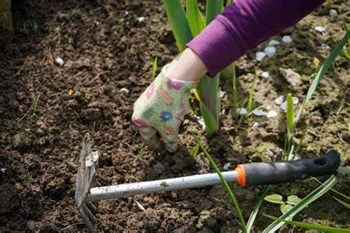



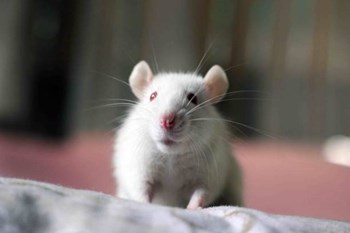
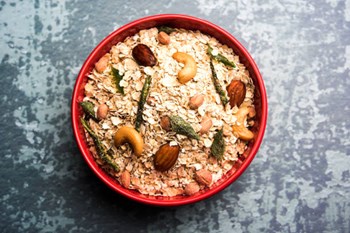











Share your comments